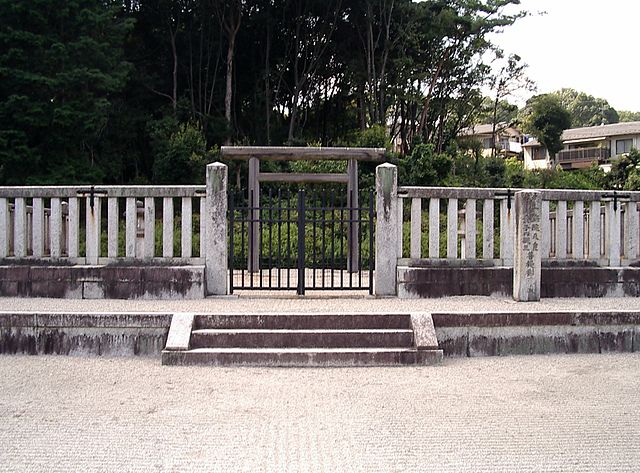Loading AI tools
Emperor of Japan From Wikipedia, the free encyclopedia
Emperor Go-Ichijō (後一条天皇, Go-Ichijō-tennō, October 12, 1008 – May 15, 1036) was the 68th emperor of Japan,[1] according to the traditional order of succession.[2]
| Emperor Go-Ichijō 後一条天皇 | |||||
|---|---|---|---|---|---|
 The birth of prince Atsuhira (Go-Ichijō) at Tsuchimikado Tei | |||||
| Emperor of Japan | |||||
| Reign | March 10, 1016 – May 15, 1036 | ||||
| Enthronement | March 24, 1016 | ||||
| Predecessor | Sanjō | ||||
| Successor | Go-Suzaku | ||||
| Born | October 12, 1008 Tsuchimikado Tei (土御門邸), Heian Kyō (Kyōto) | ||||
| Died | May 15, 1036 (aged 27) Seiryō Den (清涼殿) in Dairi (内裏), Heian Kyō (Kyōto) | ||||
| Burial | Bodaijuin no misasagi (菩提樹院陵) (Kyoto) | ||||
| Spouse | |||||
| Issue | |||||
| |||||
| House | Imperial House of Japan | ||||
| Father | Emperor Ichijō | ||||
| Mother | Fujiwara no Shōshi | ||||
Go-Ichijō's reign spanned the years from 1016 through 1036.[3]
This 11th century sovereign was named after his father, Emperor Ichijō, and go- (後), translates literally as "later"; thus, he is sometimes called the "Later Emperor Ichijō", or, in some older sources, may be identified as "Emperor Ichijō, the second."
Before his ascension to the Chrysanthemum Throne, his personal name (imina)[4] was Atsuhira -shinnō (敦成親王).[5] He was also known as Atsunari-shinnō.[6]
Atsuhira was the second son of Emperor Ichijō. His mother, Fujiwara no Akiko/Shōshi (藤原彰子) (988–1074), was a daughter of Fujiwara no Michinaga. In her later years, Ichijō's chūgo consort was known as Jōtō-mon In (上東門院).[7]
Atsuhira-shinnō was used as a pawn in Imperial court politics when he was only a child.
Atsuhira became emperor at the age of 8, upon the abdication of his first cousin once removed, Emperor Sanjō.
During the initial years of Go-Ichijō's reign, Fujiwara no Michinaga actually ruled from his position as sesshō (regent).[10]
The actual site of Go-Ichijō's grave is known.[1] This emperor is traditionally venerated at a memorial Shinto shrine (misasagi) at Kyoto.
The Imperial Household Agency designates this location as Go-Ichijō's mausoleum. It is formally named Bodaijuin no misasagi.[14]
Kugyō (公卿) is a collective term for the very few most powerful men attached to the court of the Emperor of Japan in pre-Meiji eras. Even during those years in which the court's actual influence outside the palace walls was minimal, the hierarchic organization persisted.
In general, this elite group included only three to four men at a time. These were hereditary courtiers whose experience and background would have brought them to the pinnacle of a life's career. During Go-Ichijō's reign, this apex of the Daijō-kan included:
The years of Go-Ichijō's reign are more specifically identified by more than one era name or nengō.[17]

Go-Ichijō had one Empress and two Imperial daughters.[11]
Empress (Chūgū): Fujiwara no Ishi (藤原威子; 999–1036), Fujiwara no Michinaga’s third daughter
| Ancestors of Emperor Go-Ichijō[18] | |||||||||||||||||||||||||||||||||||||||||||||||||||||||||||||||||||||||||||||||||||||||||||||||||||||||||||||||||||||||||||||||||||||||||||||||||||||||||||||||||||||||||||||||||||||||||||||||||||||||||||||||||||||||||||||||||||||||||||||||||||||||||||||||||||||||||||||||||||||||||
|---|---|---|---|---|---|---|---|---|---|---|---|---|---|---|---|---|---|---|---|---|---|---|---|---|---|---|---|---|---|---|---|---|---|---|---|---|---|---|---|---|---|---|---|---|---|---|---|---|---|---|---|---|---|---|---|---|---|---|---|---|---|---|---|---|---|---|---|---|---|---|---|---|---|---|---|---|---|---|---|---|---|---|---|---|---|---|---|---|---|---|---|---|---|---|---|---|---|---|---|---|---|---|---|---|---|---|---|---|---|---|---|---|---|---|---|---|---|---|---|---|---|---|---|---|---|---|---|---|---|---|---|---|---|---|---|---|---|---|---|---|---|---|---|---|---|---|---|---|---|---|---|---|---|---|---|---|---|---|---|---|---|---|---|---|---|---|---|---|---|---|---|---|---|---|---|---|---|---|---|---|---|---|---|---|---|---|---|---|---|---|---|---|---|---|---|---|---|---|---|---|---|---|---|---|---|---|---|---|---|---|---|---|---|---|---|---|---|---|---|---|---|---|---|---|---|---|---|---|---|---|---|---|---|---|---|---|---|---|---|---|---|---|---|---|---|---|---|---|---|---|---|---|---|---|---|---|---|---|---|---|---|---|---|---|---|---|---|---|---|---|---|---|---|---|---|---|---|---|---|---|---|
| |||||||||||||||||||||||||||||||||||||||||||||||||||||||||||||||||||||||||||||||||||||||||||||||||||||||||||||||||||||||||||||||||||||||||||||||||||||||||||||||||||||||||||||||||||||||||||||||||||||||||||||||||||||||||||||||||||||||||||||||||||||||||||||||||||||||||||||||||||||||||
Seamless Wikipedia browsing. On steroids.
Every time you click a link to Wikipedia, Wiktionary or Wikiquote in your browser's search results, it will show the modern Wikiwand interface.
Wikiwand extension is a five stars, simple, with minimum permission required to keep your browsing private, safe and transparent.